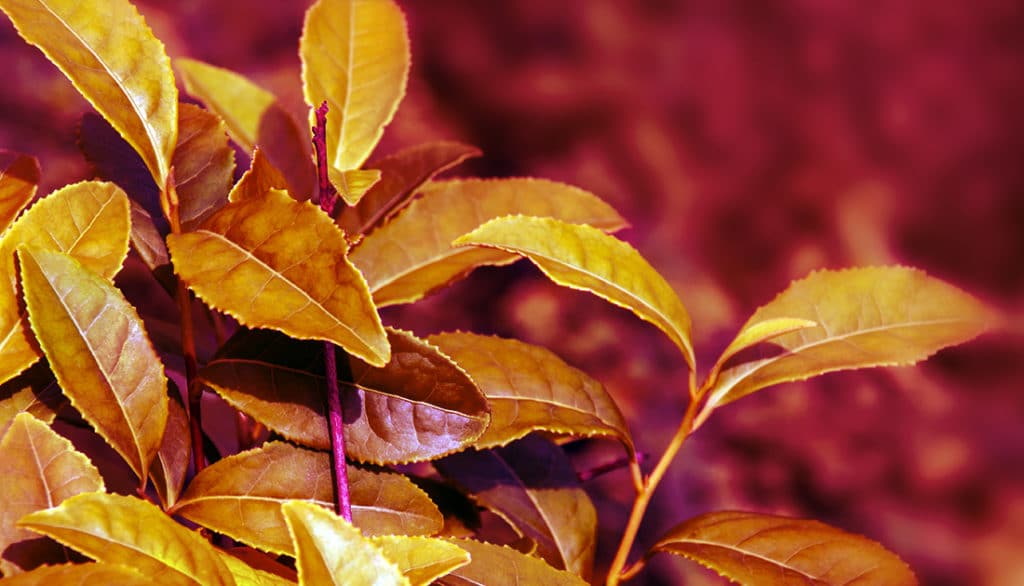If you want to know what purple tea is, how it compares to green tea, and what the benefits of drinking purple tea are, then you want to read this article.
Tea has been a staple beverage of humankind for thousands of years. Black, white, green, and oolong, tea comes in countless varieties bringing with it a boost in energy and focus along with a reduction in stress. Today, tea is synonymous with health and wellness due to the myriad of benefits attributed to its consumption, including:- Anti-Oxidation
- Antibacterial
- Anti-Viral
- Anti-Cancer
- Anti-Hypertensive
- Anti-Allergy
- Anti-Mutation
- Reduction of Elevated Blood Sugar
- Inhibition of Platelet Aggregation
- Improve Lipid Metabolism
- Plus, Many More
What is Purple Tea?
So, you haven’t heard of purple tea before? That's not surprising; it wasn't available until a few years ago and only recently has it started to catch on with individuals beyond the ones involved with its production. Purple tea is a variety of Camellia sinensis (the same tea leaf from which green tea and black tea is made) developed by the Tea Research Foundation of Kenya (TRFK) that is also currently cultivated in Kenya. <1> Purple tea is grown in colder conditions than traditional tea leaves, typically at elevations between 4,500 - 7,500 feet above sea level. This cooler environment combined with the intense UV rays leads to the development of some rather unique properties in the tea leaves which distinguishes it from tea leaves grown in other regions. Most notably, the intense UV exposure makes the leaves turn a reddish-purple hue. The reason for this color change is the presence of anthocyanins and polyphenols. In addition to giving the plant, its deep color, these compounds also help protect the tea leaves from damage. <1> But that’s not all. Antioxidants, polyphenols, and anthocyanins are important buzzwords in the health and fitness industry due to research noting the importance they play in combating oxidative stress and chronic disease caused by inflammation. Similar to green and black tea, purple tea is rife with bioactive compounds, the five most prevalent are:- EGCG (Epigallocatechin Gallate)
- GHG (1,2-di-Galloyl-4,6-Hexahydroxydipheno yl--D-Glucose)
- Theobromine
- Caffeine
- ECG (Epicatechin Gallate)

Purple Tea vs. Green Tea vs. Black Tea
Purple Tea Has More Antioxidants
Purple tea leaves are processed and prepared the same way as green tea leaves, and, while both plants contain the same five principal compounds, purple tea contains significantly higher levels of the potent polyphenols (GHG, EGCG, ECG) than green, black, or oolong teas. This also means that purple tea has higher antioxidant activity than green and black teas. Research shows it has a free-radical scavenging rate of 52%, compared with 34% for green tea and 28% for black tea. And, in case you weren't aware, the more free radicals that are neutralized by antioxidants, the lower the risk of systemic inflammation and chronic disease.Purple Tea Contains Anthocyanin
Another big difference is that purple tea contains anthocyanin. Anthocyanin is a type of flavonoid most often associated with blueberries as it is the phytochemical responsible for giving plants and berries their notable deep, dark blue or purple color. Research indicates that anthocyanins may be helpful in the treatment of numerous diseases, including cardiovascular disease, cognitive decline, and even cancer. <6> Blueberries are particularly rich in anthocyanins, but purple tea contains significantly higher amounts of anthocyanins than blueberries -- about 1.5% compared to 0.1% for blueberries. <1>Purple Tea is Lower in Caffeine Content Than Green and Black Tea
Purple tea also differs from other varieties of Camellia sinensis in its caffeine content. High-performance liquid chromatography (HPLC) has analyzed the caffeine contents of the different tea varieties and found that purple tea contains a lower amount of caffeine than green or black tea. <4>What are the Benefits of Purple Tea?
Weight Loss
In addition to the abundance of free radical-fighting polyphenols, antioxidants, and anthocyanins present in purple tea, the plant is also receiving a great deal of attention for its potential ability to aid in weight loss and cut body fat. Two small human trials using purple tea extract noted supplement aided weight loss and led to reductions in:- Body Mass Index (BMI)
- Fat Mass
- Hip Size
- Waist Size
- Subcutaneous Fat Thickness
Supports Cardiovascular Health
In addition to the decreases in weight, BMI, and waist circumference (all of which promote health and lower risk of disease), subjects also experienced a reduction in LDL ("bad") cholesterol and triglycerides -- indicating that Alluvia Purple Tea extract may confer some cardioprotective qualities as well.Supports Cognitive Health
Additional animal research notes that Kenyan purple tea significantly improves the brain's antioxidant capacity. Researchers noted that purple tea anthocyanins could cross the blood-brain barrier (BBB), bolstering the brain ability to combat free radicals and oxidative stress. <7>Purple Tea FAQ
Where Does Purple Tea Come From?
Purple tea was initially found as naturally occurring wild mutations of Camellia sinensis in China. Subsequently, a public/private partnership was founded in Kenya to identify and isolate this mutation, then find a way to produce Purple tea in mass quantity. Purple tea is grown at elevations between 4,500 - 7,500 feet predominantly in the Nandi Hills region of Kenya. The cool environment combined with the intense UV rays of the high altitude led to the formation of anthocyanins in the tea leaves, which gives the plant its distinct purple hue.Is Purple Tea Caffeinated?
Yes, purple tea does contain caffeine, but not as much as black tea or even green tea. Alluvia purple tea extract contains 4.5% caffeine.How Do You Make (Brew) Purple Tea?
Purple tea is brewed similar to green and black tea -- pour freshly boiled water over loose tea leaves and steep for 3-4 minutes. Purple tea is fairly "forgiving" in that if you let it steep an extra minute or two, it won't develop the bitterness or astringency familiar with other teas. Now, if you want to get fancy with your cup of tea….- Fill a kettle with a bottle or filtered water and bring to a boil
- Pour the boiling water into a teapot, and then empty the water into a pitcher or bowl to cool.
- Place one teaspoon (2 grams) of dried purple tea leaf into the teapot
- Pour boiling water from the kettle onto the tea leaves until the teapot is half full.
- Now, pour out this water, while retaining the tea leaves. (This is a “rinsing” of the tea leaves.)
- Once the water reserved in the pitcher as cooled slightly (~160℉), pour it into the teapot.
- Allow tea too steep for 3 minutes.
- Pour tea into the pitcher through a fine mesh strainer.
- You may choose to drink the tea now or perform a second (and third) infusion using the same temperature of water and steeping time.
Where Can I Find Purple Tea Extract?
Chances are pretty good that your local tea shop or grocery store isn't lining the shelves with purple tea. Now, you can quickly go and order some off the internet, but ensuring that you're getting authentic, high-quality tea direct from the hills of Kenya can be a bit of a crapshoot. If you’d rather not waste time sourcing and vetting tea suppliers, but still want to get all the potential health and weight loss benefits of purple tea, our go to choice is Alluvia™ Purple Tea. Alluvia™ Purple Tea is a standardized extract of purple tea containing 50% polyphenols, almost 10% EGCG, 1.5% anthocyanins, and 7.4% GHG. SteelFit® Shredded Steel contains 100mg of Alluvia™ Purple Tea -- the same dose used in the human studies noting improvements in BMI, body composition, and waist circumference. Click Here to learn more about Shredded Steel and how it can help support your weight loss goals.References
- Ltd, O. O. & F. C. C. (2013). Purple Tea Extract, 0–34.
- Yagi K, Goto K, Nanjo F. Identification of a major polyphenol and polyphenolic composition in leaves of Camellia irrawadiensis . Chem. Pharm. Bull. 2009;57:1284.
- “Total polyphenols, catechin profiles and antioxidant activity of tea products from purple leaf coloured tea cultivars.” Food Chem. 2013 Feb 15;136(3-4):1405-13.
- Shimoda H, Hitoe S, Nakamura S, Matsuda H. Purple Tea and Its Extract Suppress Diet-induced Fat Accumulation in Mice and Human Subjects by Inhibiting Fat Absorption and Enhancing Hepatic Carnitine Palmitoyltransferase Expression. Int J Biomed Sci. 2015;11(2):67-75.
- Alluvia ™ Purple Tea Overview. (2014), 914.
- Lila MA. Anthocyanins and Human Health: An In Vitro Investigative Approach. J Biomed Biotechnol. 2004;2004(5):306-313.
- Rashid K , et al. "Kenyan Purple Tea Anthocyanins Ability to Cross the Blood Brain Barrier and Reinforce Brain Antioxidant Capacity in Mice. - PubMed - NCBI." National Center for Biotechnology Information.

